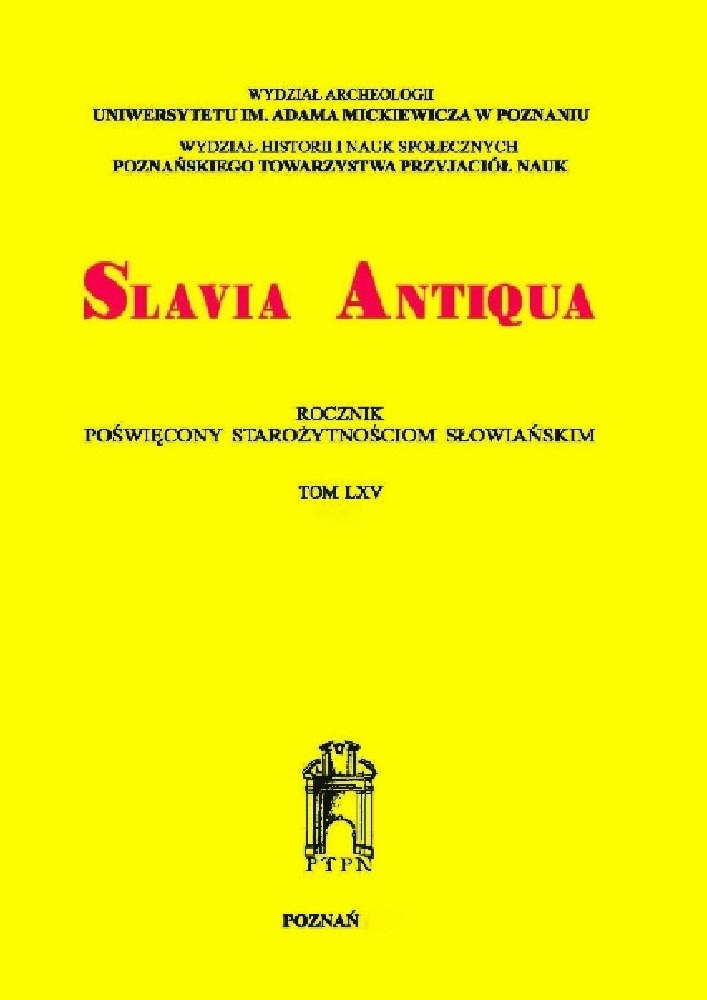Abstract
The cult of Triglav in the Polabian-Pomeranian territory in the 12th century confirms an evolution of the religious system of the local Slavic communities towards monolatry, largely affected by confrontation as well as a cultural dialogue with the Christian culture. At first, at the time of the Pomeranian missions of Saint Otto of Bamberg in the 1120s, attempts at suppressing the cult did not bring about long-term effects. However, a wave of the so-called pagan reaction led to some sort of a compromise made in Szczecin, leading to official coexistence of the cult of Triglav and the newly introduced cult of Jesus Christ. From the point of view of mythology, the competences of the two divine figures turn out to be convergent and universal, yet still, as part of the Szczecin “religious dualism”, no attempt was made to identify them (following the rule of interpretatio Slavica of the elements of Christianity). The belief in the autonomy of Triglav and Christ (“A German God”) was confirmed in Szczecin in the course of Otto’s evangelization which resulted in a Christian community in the city. The phenomenon of syncretism, present there until Otto’s second mission (1128), was therefore an attempt at maintaining unity in a religiously divided society following the first mission of the Apostle of Pomeranians (1124-1125).
References
Magistri Adam Bremensis Gesta Hammmaburgensis Ecclesiae Pontificum, wyd. B. Schmeidler, MGH, Scriptores rerum Germanicarum in usum scholarum, Hannover–Lipsk 1917.
Ebo, Żywot św. Ottona biskupa bamberskiego, wyd. J. Wikarjak, wstęp i oprac. K. Liman, MPH s.n., t. 7, cz. 2, Warszawa 1974.
Ekkechardi Uraugiensis chronica, wyd. D.G. Waitz, MGH, Scriptores, t. 6, Hannoverae 1844.
Heinrici de Antwerpe Tractatus de captione urbis Brandenburgensis, wyd. O. Holder-Egger, Monumenta Germaniae Historica Scriptores, t. 25, Hannover 1880.
Helmoldi presbyteri bozoviensis Chronica Slavorum, wyd. B. Schmeidler, MGH. Scriptores rerum Germanicarum in usum scholarum, Hannoverae 1937.
Herbord, Dialog o życiu św. Ottona biskupa bamberskiego, w: MPH s.n., t. 7, cz. 3, wyd. J. Wikarjak, wstęp i oprac. K. Liman, Warszawa 1974.
Die Prüfeninger Vita Bischof Ottos I. von Bamberg nach der Fassung des Groβen Österreichischen Legendars, Monumenta Germaniae Historica, Scriptores Rerum Germanicarum, wyd. J. Petersohn, Hannover 1999.
Biblia Sacra juxta Vulgatam Clementinam. Editio electronica, wyd. M. Tvveedale, Londini 2005.
Banaszkiewicz J. 1996, Pan Rugii – Rugiewit i jego towarzysze z Gardźca: Porewit i Porenut (Saxo Gramatyk, Gesta Danorum, XIV, 39, 38-41), w: Z. Kurnatowska (red.), Słowiańszczyzna w Europie średniowiecznej, t. 1, Wrocław, s. 75-82.
Banaszkiewicz J. 1998 Polskie dzieje bajeczne mistrza Wincentego Kadłubka, Wrocław.
Demm E. 1970, Reformmönchtum und Slawenmission im 12. Jahrhundert. Wertsoziologisch-geistesgeschichtliche Untersuchungen zu den Viten Bischof Ottos von Bamberg, Lübeck-Hammburg.
Gieysztor A. 2006, Mitologia Słowian, wstęp K. Modzelewski, oprac. A. Pieniądz, posłowie L.P. Słupecki, Warszawa.
Haarländer S. 2000, Vitae episcoporum. Eine Quellengattung zwischen Hagiographie und Historiographie, untersucht an Lebensbeschreibungen von Bischöfen des Regnum Teutonicum im Zeitalter der Ottonen und Salier, Stuttgart, s. 527-535.
Lamm J.P. 1987, On the cult of multiple-headed gods in England and the Baltic area, Przegląd Archeologiczny 34, s. 219-231.
Liman K. 1975, Dialog Herborda. Ze studiów historycznoliterackich nad biografią łacińską XII wieku, Poznań.
Miś A.L. 1997, Przedchrześcijańska religia Rugian. Slavia Antiqua, 38, s. 105-149.
Petersohn J. 1962, Zum mittelaterlichen Kulteinfluss Bamberg auf Pommern. Heinrichs- und Kunigundenverehrung in Stettin., Bericht des Historischen Vereins Bamberg, 98, s. 345-347.
Petersohn J.1966, Apostolus Pomeranorum. Studien zur Geschichte und Bedeutung des Apostelepithetons Bischof Otto I. von Bamberg, Historisches Jahrbuch 86, z. 2, s. 257-294.
Petersohn J. 1999, Einleitung, w: Die Prüfeninger Vita Bischof Ottos I. von Bamberg nach der Fassung des Groβen Österreichischen Legendars, Monumenta Germaniae Historica, Scriptores Rerum Germanicarum, wyd. J. Petersohn., Hannover, s. 1-43.
Procházka V. 1958, Organisace kultu a kmenove zřizeni polabsko-pobaltskych slovanů, Vznik a počatki slovanů 2, s. 145-167.
Rosik S. 1995, Udział chrześcijaństwa w powstaniu policefalnych posągów kultowych u Słowian zachodnich, Wrocław (Prace Historyczne 17).
Rosik S. 2010, Conversio gentis Pomeranorum. Studium świadectwa od wydarzeniu (XII wiek), Wrocław.
Słupecki L.P. 1994, Slavonic Pagan Sanctuaries, Warsaw.
Rosik S. 2003, Wrożbiarstwo pogańskich Słowian, w: M. Dulinicz (red.), Słowianie i ich sąsiedzi we wczesnym średniowieczu, Warszawa-Lublin, s. 73-80.
Strzelczyk J. 2005, Einleitung, w: Heiligenleben zur Deutsch-Slawischen Geschichte. Adalbert von Prag und Otto von Bamberg, (wyd.) L. Weinrich, współpraca J. Strzelczyk, w: Ausgewählte Quellen zur Deutschen Geschichte des Mittelalters, t. 23, (red.) H.W. Goetz, Darmstadt, s. 18-26.
Strzelczyk J. 2007, Mity, podania i wierzenia dawnych Słowian, Poznań.
Urbańczyk S. 1991, Dawni Słowianie. Wiara i kult, Wrocław-Warszawa-Kraków.
License

This work is licensed under a Creative Commons Attribution-NoDerivatives 4.0 International License.

